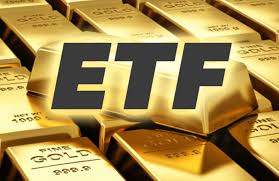All You Need To Know About Gold ETF (1)

Gold ETF
Gold ETF Fund (Exchange Traded Fund) is a gold-based assets, tracking A financial derivative of the fluctuating price of spot gold, which can be traded on the stock market. Due to the high price of gold, gold ETFs typically have a net asset price per unit in 1/10th of an ounce units That is the 1/10 ounce spot gold price minus accrued overhead costs. Its trading or secondary market price on the stock market is based on the net asset price per share.
Operating Principle
The operation principle of gold ETF is: from large gold producers to fund companies consignment of physical gold, and then by the fund companies to this physical gold as the basis, in the exchange of public offering fund shares, sales to all kinds of investors, commercial banks act as fund trustees and physical custody line, investors in the duration of the fund can be free to redeem.
Gold ETFs are listed on the stock exchange, allowing investors to trade gold ETFs as easily as they trade stocks. A major advantage of gold ETFs. Investors buying gold ETFs are exempt from the costs of gold custody, storage and insurance, paying only fees that are usually about 0.3 percent The -0.4% management fee is a significant advantage over the 2% to 3% average fees of other gold investment channels. In addition, gold ETFs offer the advantages of safekeeping and liquidity.
history
In 2003, the world's first gold ETF was listed in Sydney, and 2004 was a year of great growth for gold ETFs. 3 gold ETFs were created and made a giant of the gold ETF market - StreetTracks Gold Trust Fund (NYSE GLD). The fund is managed by World Gold Trust Services, (LLC), which began trading on the New York Stock Exchange (NYSE) on November 18, 2004, at its peak Over 400 tons of gold were held. Gold ETF products have since sparked a global subscription boom and were once considered by Wall Street analysts to have directly contributed to the 2004 The price of gold later in the year.
Fund characteristics
High liquidity, with AP model escort to ensure high liquidity
Gold ETF market makers in the AP model are obligated to make markets, have better secondary market liquidity, lower shock costs, and can offer bulk trading Service! Non-AP model market makers have no market making obligations.
2. Low threshold, starting at about $300 per gram per lot
Trading unit is 1 gram of gold per lot, while the Gold Exchange starts at 50 grams.
3. Low fees, with transaction costs much lower than physical gold fees
Commissions are equivalent to stock ETFs, ranging from 0.03% to 0.08%, while GME's commercial bank agents are generally 0.2 per cent
4. configured, securities accounts can directly trade gold
After the securitization of gold assets, investors can more conveniently participate in gold investment, the field can allocate and trade gold
Investment Advantages
Convenient trading
Gold ETFs are listed on stock exchanges, such as StreetTracks Gold Trust (GLD) on the New York Stock Exchange, Gold Bullion Securities (GBS) on the London Stock Exchange and Euronext, and Gold Bullion Securities (GOLD) on the Australian Stock Exchange, allowing investors to trade gold ETFs as conveniently as they trade stocks.
Keeping it safe
An investor who buys shares of the fund is holding spot gold. The gold is usually stored in the Fund's vaults at the Fund's custodian in the form of London Bullion Association deliverable bars for standard delivery and is extremely safe.
Low transaction costs
Investors can buy gold ETFs free of fees, storage and insurance fees for gold, paying only about 0.40% Management fees have a significant advantage over other investment methods with rates of about 2% to 3%.
high mobility
Gold ETFs exist in both primary and secondary markets, and there are market agents or market makers actively trading in the market, which, coupled with the huge stock in the gold ETF market, greatly protects trading liquidity.
transaction transparency
Global gold trading is 24 hours continuous trading and very transparent prices.
Trading flexibility
Market orders, limit orders and stop orders can be placed as needed in major gold ETFs. In addition, funds such as GLD can also sell short and offer margin trading options with very flexible trading tools.



